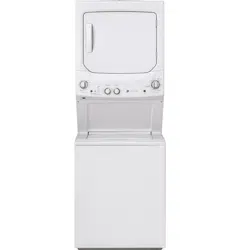Documents: Go to download!
User Manual
- User Manual - (English, French, Spanish)
- Energy Guide - (English)
- Installation Instruction - (English)
- CAD files 2D - (English)
- CAD files 2D Plan - (English)
- CAD file 3D - (English)
- Specification - (English)
- USING THE WASHER
- CARE AND CLEANING
- TROUBLESHOOTING TIPS
Table of contents
OWNER’S MANUAL
USING THE WASHER
Getting started - Washer
Through this manual, features and appearance may vary from your model.

NOTE: This appliance is designed so that the washer and dryer can be operated at the same time.

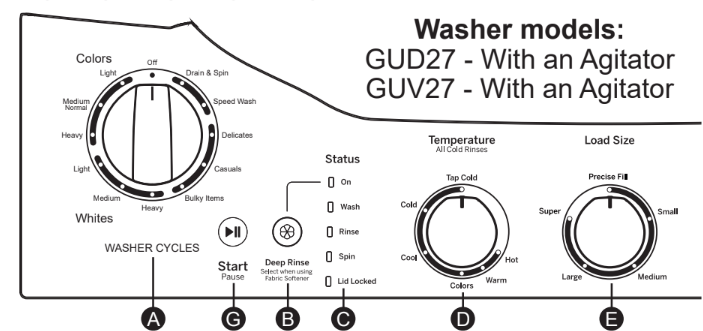
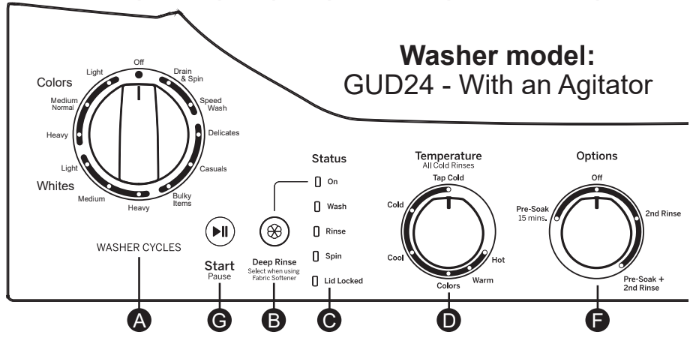
A. Washer Cycles The washer cycle controls the type of washing process. The cycle selector knob can be turned in either direction. Turning the knob after starting a cycle will stop the washer and change the cycle to the new selection. Press Start to begin the new cycle selection. The chart below will help you match the items to be washed with the best washer cycle settings. For optimal performance, select the cycle that most closely matches the items being washed. Selections shown in bold are the recommended settings for that cycle. Off - Washer is turned off and the Start button does not function. NOTE: When the control is turned to Off, the Status lights are off.
B. Deep Rinse Set this option when adding fabric softener to the washer.
C. Status lights The Status lights show the stage the washer is in. When the selector knob is set to a new cycle, the Status lights will flash momentarily, showing the stages the cycle will go through.
- On: When the fabric softener option has been selected.
- Wash: When the washer is in the wash portion of the cycle.
- Rinse: When the washer is in the rinse portion of the cycle. Spin When the washer is draining and/or spinning.
- Lid Locked: When the washer lid is locked. This feature prevents the lid from being opened while the washer is in the spin cycle or coasting to a stop
D. Temperature Select the water temperature for the washer cycle (all rinses use cold water). Always follow fabric manufacturer’s care label or instructions when laundering. Tap Cold: uses incoming tap water, which can provide energy savings. For all other temperature selections, a mixture of hot and cold water is used to achieve the ideal temperature for each temperature setting.
E. Load Size (on some models) Loosely load clothes no higher than the top row of holes in the washer basket. Precise Fill - This selection automatically provides the correct amount of water suited to the size and type of load placed in the unit. If you prefer to manually select the water level, select Small through Super. While Precise Fill is best for most loads and general washing, you may want to manually select the load size for specialty items such as bulky, lightweight comforters or pillows, where you want to ensure a larger water level is applied. Manual load size selections should be made for wet items placed in the washer, such as soaked towels or garments.
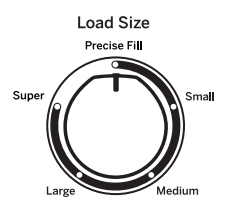
F. Options (on some models) Pre-Soak 15 mins. - This option begins with a brief agitation, soaks for this specified period of time, then moves through the rest of the cycle automatically. 2nd Rinse - When you use extra detergent or bleach to clean heavily soiled clothes, use the 2nd Rinse option to better remove additional residues. Pre-Soak + 2nd Rinse - Turns both options on. Off - Turns these options off
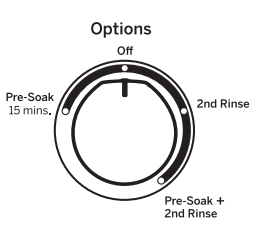
G. Start Press Start to begin the cycle. With the lid closed pressing Start again will pause the cycle and Status lights will blink. To continue the cycle, close the lid and press Start again. The water fill will continue with the lid opened, except when Precise Fill (on some models) is selected as the load size. The lid must be closed to continue filling when Precise Fill (on some models) is selected. If the lid is opened during the cycle, the cycle will pause and the Status lights will blink. To resume the cycle, close the lid and press Start. If the machine is paused for more than 24 hours, the cycle will be cancelled. To stop the cycle, turn the Cycle Selector to the Off position. NOTE: Machine will automatically cancel and drain when water is present and the lid is left open for 15 minutes or the unit is left in a paused state for 24 hours with the lid closed. Select cycle and press Start to begin new cycle.
Liquid Bleach Funnel - The water fill dilutes liquid chlorine bleach as the washer fills for the washer cycle.
- Check clothing care labels for special instructions.
- Measure liquid bleach carefully, following instructions on the bottle.
- Never pour undiluted liquid chlorine bleach directly onto clothes or into the wash basket.
- Do not pour powdered bleach into bleach funnel.
3. Before starting the washer, pour measured amount of bleach directly into bleach funnel. Avoid splashing or over-filling dispenser. If you prefer to use powdered bleach, add it into the wash basket with your detergent.
-199199.png)
- Do not mix chlorine bleach with an oxi pre-treatment, ammonia or acids such as vinegar and/or rust remover. Mixing can produce a toxic gas which may cause death. NOTE: Do not pour bleach into FABRIC SOFTENER dispenser.
Sorting Wash Loads
Sort by color (whites, lights, colors), soil level, fabric type (sturdy cottons, easy care, delicates) and whether the fabric produces lint (terry cloth, chenille) or collects lint (velveteen, corduroy). Wash lint producers such as cotton towels and socks separate from lint collectors including synthetic garments and dress pants.
Loading the Washer (on models with an agitator) Load dry items loosely, no higher than the top row of holes in the washer basket. When loading wet items, make sure you set the load/water level high enough to allow the items to move freely. To add items after washer has started, press Start/Pause. Lift the lid and submerge additional items next to the agitator. Close the lid and press Start to resume.
- Do not wrap long items like sheets or pants around the agitator.
- Do not wash fabrics containing flammable materials (waxes, cleaning fluids, etc.).
- Agitation will not start with the lid up.

Loading the Washer (on models with an infusor) Load dry items loosely in the washer basket. For best results, load items evenly and loosely around the outside of the basket, filling in towards the center on larger loads. To add items after washer has started, press Start/Pause. Lift the lid and submerge additional items around the outside of the basket. Close the lid and press Start to resume.
- Do not place large items such as sheets, blankets and towels across the Infusor. Load them around the outside of the basket.
- Do not wash fabrics containing flammable materials (waxes, cleaning fluids, etc.).
- Wash action will not start with the lid up.

Proper Use of Detergent
Using too little or too much detergent is a common cause of laundry problems. Use less detergent if you have soft water, a smaller load or a lightly soiled load. For spots, apply pre-treatment to items as recommended on the product label. Application should be made in the basket to prevent overspray which may cause the coloring on the lid or graphics to fade. Place detergent packets in the bottom of the wash basket before adding clothes.
We recommend the use of High Efficiency detergents such as  in your energy efficient washer. HE detergents are formulated to work with low water wash and rinse systems. HE detergents reduce the oversudsing problems commonly associated with regular detergents.
in your energy efficient washer. HE detergents are formulated to work with low water wash and rinse systems. HE detergents reduce the oversudsing problems commonly associated with regular detergents.
When using high efficiency or concentrated detergents, consult the product label to determine amount required for optimum performance. Excessive detergent will negatively impact wash performance.
Getting started - Dryer
Through this manual, features and appearance may vary from your model.
IMPORTANT: Clean the lint filter each time you use the dryer.
For models without E-Dry:

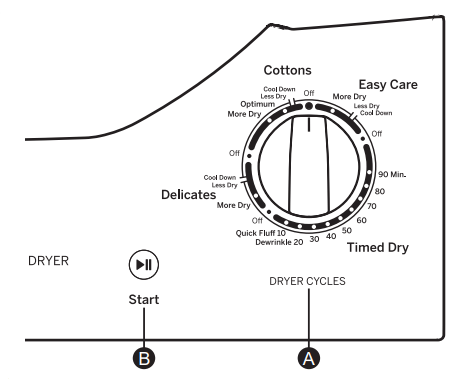
For models with E-Dry:
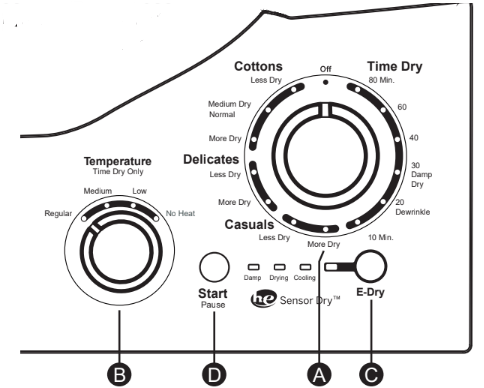
 Venting the Dryer
Venting the Dryer
For the best drying performance, the dryer needs to be properly vented. The dryer will use more energy and run longer if it is not vented to the specifications below. Carefully follow the details on Exhausting in the Installation Instructions.

Ductwork that runs through an unheated area or that is near air conditioning should be insulated to reduce condensation and lint build-up
CARE AND CLEANING
Care and cleaning - Washer
Exterior of the Washer
Immediately wipe off any spills with a damp cloth.
Interior of the Washer
Leave the lid open after washing to allow moisture to evaporate. If you want to clean the basket, use a clean soft cloth dampened with liquid detergent; then rinse. (Do not use harsh or gritty cleaners).
Cleaning the Fabric Softener Dispenser (on some models)
1. Remove the dispenser from the top of the agitator.
2. Separate the dispenser cup from the cover by grasping the top and pushing down on the inside of the cup with your fingers. Dispenser cup will pop free from the cover.
3. To clean the dispenser, soak both the dispenser cup and the dispenser cover in the following solution:
- 1 US gallon (3.8 liters) warm water
- 1/4 cup (60 ml) heavy-duty liquid detergent
- 1 cup (240 ml) bleach
4. If necessary, loosen buildup with a clean, soft cloth after soaking. Do not use a stiff brush; you may roughen the surface of the dispenser.
5. Rinse and reassemble dispenser. Place dispenser back on the agitator.
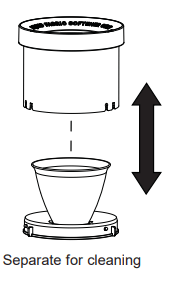
Water Supply Hoses
Hoses connecting washer to faucet should be replaced every 5 years.
Moving and Storage
Ask the service technician to remove water from drain pump and hoses. Do not store the washer where it will be exposed to the weather.
Long Vacations
Be sure water supply is shut off at faucets. Drain all water from hoses and water filter pump area if weather will be below freezing.
Care and Cleaning - Dryer
The Exterior: Wipe or dust any spills or washing compounds with a damp cloth. Dryer control panel and finishes may be damaged by some laundry pretreatment soil and stain remover products. Apply these products away from the dryer. The fabric may then be washed and dried normally. Damage to your dryer caused by these products is not covered by your warranty.
The Lint Filter: Clean the lint filter before each use. Slide out the grid that covers the filter. Run your fingers across the filter. A waxy buildup may form on the lint filter from using dryer-added fabric softener sheets. To remove this buildup, wash the lint screen in warm, soapy water. Dry thoroughly and replace. Do not operate the dryer without the lint filter and grid in place. Have a qualified technician vacuum the lint from the dryer once a year.
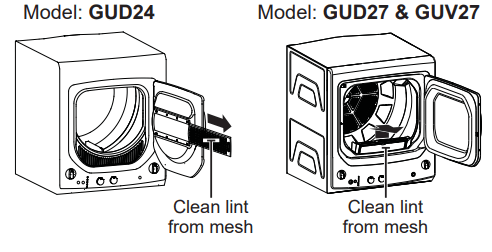
Dryer Interior and Duct: The interior of the appliance and exhaust duct should be cleaned once a year
by qualified service personnel.
The Exhaust Duct: Inspect and clean the exhaust ducting at least once a year to prevent clogging. A partially clogged exhaust can lengthen the drying time.
Follow these steps:
- Turn off electrical supply by disconnecting the plug from the wall socket.
- Disconnect the duct from the dryer.
- Vacuum the duct with the hose attachment and reconnect the duct.
The Exhaust Hood: Check with a mirror that the inside flaps of the hood move freely when operating. Make sure that there is no wildlife (birds, insects, etc.) nesting inside the duct or hood.
TROUBLESHOOTING TIPS
Troubleshooting tips - Washer
Water
Too many suds
- Too much detergent or soft water
- Measure your detergent carefully. Use less soap if you have soft water, a smaller load or a lightly soiled load.
Water leaks
- Using too much detergent
- Use less detergent. Use less soap if you have soft water, a smaller load or a lightly soiled load.
- Fill hoses or drain hose is improperly connected
- Make sure hose connections are tight at faucets and rubber washers are installed. Make sure end of drain hose is correctly inserted in and secured to drain facility.
- Household drain may be clogged
- Check household plumbing. You may need to call a plumber.
- Constant water pressure to fill hoses at water source
- Tighten hoses at the faucets and turn the water off after each use. Check condition of fill hoses; they should be replaced every 5 years.
Water temperature seems incorrect
- Cooler water temperatures provide improved energy efficiency
- New laundry detergents have been formulated to work with cooler water temperatures without affecting wash performance.
- Water supply is turned off or improperly connected
- Turn both hot and cold faucets fully on and make sure hoses are connected to correct faucets.
- Water valve screens are stopped up
- Turn off the water source and remove the water connection hoses from the upper back of the washer. Use a brush or toothpick to clean the screens in the machine. Reconnect the hoses and turn the water back on.
- House water heater is not set properly
- Make sure house water heater is delivering water at 120°F–140°F (48°C– 60°C).
Water pumped out before cycle is complete
- Water was left in unit for 24 hours with lid closed or 15 minutes with lid open
- Previous cycle has been cancelled. Close lid, select new cycle, and start machine.
Water won’t drain
- Drain hose is kinked or improperly connected
- Straighten drain hose and make sure washer is not sitting on it. Top of drain outlet should be less than 8 ft (2.5 m) above floor.
Washer pauses during spin cycle
- This is normal. The washer may pause during the spin cycle to remove soapy water more efficiently
Can hear but not see water at the end of the cycle
- This is normal. The pump pleaves a little water in its intake and this is diluted with clean rinse water.
Water level seems low
- This is normal. Water may not cover the top level of the clothes. This is normal for this high efficiency washer.
Water levels lower than previous washer
- This is normal for a high efficiency washer with an infusor
- A washer with an infusor is a high efficiency washing machine. This system requires less water while providing effective cleaning action. You may notice that the water level is lower than on your previous washer.
Water siphoning out of washer
- Drain standpipe is too low or hose too far into standpipe
- The drain hose must exceed 30” height at some point between the washer back and the drain pipe. Use anti-siphon clip. See the Installation Instructions.
Operation
Washer won’t operate
- Washer is unplugged
- Make sure cord is plugged securely into a working outlet.
- Water supply is turned off
- Turn both hot and cold faucets fully on.
- Controls not set properly
- Check controls.
- Lid is open—safety feature prevents agitation and spinning when lid is up
- Close lid and reset cycle, to the beginning if necessary.
- Circuit breaker/fuse is tripped/blown
- Check house circuit breakers/fuses. Replace fuses or reset breaker. Washer should have separate outlet.
- Electronics need reset
- Unplug washer, wait 2 minutes, plug back in and press Start. Start was not pressed Press Start.
Movement inside machine when shut off
- Shifting mechanism is disengaging the motor
- When the machine is manually turned off, the shifter will disengage the motor before completely shutting down. If lid is raised before the motor is disengaged, it will resume when lid is closed.
Short spray and delay after pushing the Start button
- Lid was opened and closed between cycle selection and start
- This is normal. See START-UP SEQUENCE in the Safety Instructions section.
Washer spins and pauses at the beginning of cycles
- This is normal. The washer is sensing the load.
Washer pauses during wash cycle
- The Soak Option was chosen
- This is normal. The washer alternates between agitate and soak during these cycles to get your clothes cleaner with less wear.
- This is normal. Many cycles incorporate as series of soaks within the agitation period to get your clothes clean with less wear
Basket seems loose
- Basket moves or rotates freely
- Washer basket does not have a traditional brake. Washer basket will move freely. This is normal.
Spin time longer than previous washer
- This is normal for a high efficiency washer with an infusor
- A washer with an infusor is a high efficiency washing machine. Extra spin time typically reduces dryer time/energy usage (i.e. reduces total energy when using both a washer and a dryer). You may notice that the spin time is longer than on your previous washer.
Blinking Spin light or Spin light on at end of cycle
- Out of balance condition has been detected
- Allow cycle to continue and finish. If load is wet at the end of the cycle, even out load and run a Drain & Spin cycle.
Performance
Clothes too wet
- Incorrect spin cycle selected
- Make sure the spin cycle selected matches the load you are washing. Some fabrics will feel wetter when rinsed with cold water.
- Wash load out of balance
- Redistribute load in washer and run through Drain & Spin cycle.
Colored spots
- Incorrect use of fabric softener
- Check fabric softener package for instructions and follow directions for using dispenser. Pretreat stain and rewash.
- Dye transfer
- Sort whites or lightly colored items from dark colors
Grayed or yellowed clothes
- Detergent amount
- Be sure to follow detergent manufacturer’s directions.
- Hard water
- Use a water conditioner like Calgon brand or install a water softener.
- Water is not hot enough
- Make sure water heater is delivering water at 120°F–140°F (48°C– 60°C). Washer is overloaded Select load size to match clothes load.
- Dye transfer
- Sort clothes by color. If fabric label states wash separately, unstable dyes may be indicated.
Lint or residue on clothes
- Clothes are air or line dried
- If you do not dry your clothes with a clothes dryer, your clothes may retain more lint.
- Incorrect sorting
- Separate lint producers from lint collectors.
- Washing too long
- Wash small loads for a shorter time than larger loads
- Detergent not dissolving
- Add detergent as wash basket fills with water, before you load clothes. Try a liquid detergent. Use warmer water temperature.
- Overloading
- Load clothes no higher than the top row of holes in the washer basket.
- Incorrect use of fabric softener
- Check fabric softener package for instructions and follow directions for using dispenser.
Pilling
- Result of normal wear on poly-cotton blends and fuzzy fabrics
- While this is not caused by the washer, you can slow the pilling process by washing garments inside out.
Snags, holes, tears, rips or excessive wear
- Pins, snaps, hooks, sharp buttons, belt buckles, zippers and sharp objects left in pockets
- Fasten snaps, hooks, buttons and zippers.
- Remove loose items like pins, objects in pockets and sharp buttons.
- Turn knits (which snag easily) inside out.
- Undiluted chlorine bleach
- Check bleach package instructions for proper amount. Never add undiluted bleach to wash or allow clothes to come in contact with undiluted bleach.
- Chemicals like hair bleach or dye, permanent wave solution
- Rinse items that may have chemicals on them before washing.
Wrinkling
- Improper sorting
- Avoid mixing heavy items (like work clothes) with light items (like blouses).
- Try a fabric softener.
- Overloading or incorrect water level
- Load your washer so clothes have enough room to move freely with water covering all of the clothes.
- Incorrect wash and dry cycles
- Match Cycle selection to the type of fabric you are washing (especially for easy care loads).
- Repeated washing in water that is too hot
- Wash in warm or cold water.
Sounds
“Metallic clicking”
- Shifter mechanism is engaging or disengaging
- The drive system will engage at the start of agitate and disengage when agitate is complete. This occurs multiple times during the wash.
Back and forth “swoosh” or light “clicking” sound during agitate
- Electric motor reversing direction
- This sound is the motor rotating back and forth to agitate your laundry.
Quick short agitation sounds
- Clothing redistribution
- At different periods of the agitation phase, the motor makes short agitation strokes to redistribute the load.
“Click” when water stops filling
- Relay switch
- The relay makes a click sound when activated. The water level activates the relay and stops filling.
“Clicking” behind control panel during fill
- Automatic Temperature Control Valve
- This valve mixes in cold and hot water.The “clicking” is the valve turning on and off.
Water volume changes during fill
- Automatic Temperature Control Valve
- This valve mixes in cold and hot water. The sound changes when the valves are turned on and off.
Motor “whinding up” or “coasting down” in spin
- Motor ramping up/down during spin cycle
- The motor will speed up incrementally during the spin cycle. When spin is complete, it will coast until it stops.
“Humming”
- Water drain pump
- The drain pump will make a humming sound when pumping out water after agitation stops and continue until spin is complete.
“Gurgling”
- Water drain pump
- When the pump starts drawing in air, It starts to gurgle. The washer should then begin spinning and the sound will continue until it is done spinning.
Troubleshooting Tips - Dryer
Dryer doesn’t start
- Dryer is unplugged
- Make sure the dryer plug is pushed completely into the outlet.
- Fuse is blown/circuit breaker is tripped
- Check the house fuse/circuit breaker box and replace fuse or reset breaker. Note: Most electric dryers use 2 fuses/ breakers.
Dryer doesn’t heat
- Fuse is blown/circuit breaker is tripped; the dryer may tumble but not heat
- Check the house fuse/circuit breaker box and replace both fuses or reset both breakers. Your dryer may tumble if only one fuse is blown or one breaker tripped.
- Gas service is off
- Make sure gas shutoff at dryer and main shutoff are fully open.
Dryer shakes or makes noise
- Some shaking/noise is normal. Dryer may be sitting unevenly
- Move dryer to an even floor space, or adjust leveling legs as necessary until even.
Greasy spots on clothes
- Improper use of fabric softener
- Follow directions on fabric softener package.
- Drying dirty items with clean ones
- Use your dryer to dry only clean items. Dirty items can stain clean items and the dryer.
- Clothes were not completely clean
- Sometimes stains which cannot be seen when the clothes are wet appear after drying. Use proper washing procedures before drying.
Lint on clothes
- Lint filter is full
- Clean lint screen before each load.
- Improper sorting
- Sort lint producers (like chenille) from lint collectors (like corduroy).
- Static electricity can attract lint
- See suggestions in this section under STATIC.
- Overloading
- Separate large loads into smaller ones.
- Paper, tissue, etc. left in pockets
- Empty all pockets before laundering clothes.
Static occurs
- No fabric softener was used
- Try a fabric softener.
- Bounce™ Fabric Conditioner Dryer Sheets have been approved for use in all GE Appliances dryers when used in accordance with the manufacturer’s instructions.
- Overdrying
- Try a fabric softener. Adjust setting to Less Dry.
- Synthetics, permanent press and blends can cause static
- Try a fabric softener.
Inconsistent drying times
- Type of heat
- Automatic drying times will vary according to the type of heat used (electric, natural or LP gas), size of load, types of fabrics, wetness of clothes and condition of exhaust ducts.
Clothes take too long to dry
- Improper sorting
- Separate heavy items from lightweight items (generally, a well-sorted washer load is a well-sorted dryer load).
- Large loads of heavy fabrics (like beach towels)
- Large, heavy fabrics contain more moisture and take longer to dry. Separate large, heavy fabrics into smaller loads to speed drying time.
- Controls improperly set
- Match control settings to the load you are drying.
- Lint filter is full
- Clean lint filter before every load.
- Improper or obstructed ducting
- Check installation instructions for proper ducting/venting.
- Make sure ducting is clean, free of kinks and unobstructed.
- Check to see if outside wall damper operates easily.
- Check the Installation Instructions to make sure the dryer venting is correct.
- Blown fuses or tripped circuit breaker
- Replace fuses or reset circuit breakers. Since most dryers use 2 fuses/breakers, make sure both are operating.
- Overloading/combining loads
- Do not put more than one washer load in the dryer at a time.
- Underloading
- If you are drying only one or two items, add a few items to ensure proper tumbling.
Clothes are wrinkled
- Overdrying
- Select a shorter drying time.
- Remove items while they still hold a slight amount of moisture. Select a Less Dry setting.
- Letting items sit in dryer after cycle ends
- Remove items when cycle ends and fold or hang immediately.
- Overloading
- Separate large loads into smaller ones
Clothes shrink
- Some fabrics will naturally shrink when washed. Others can be safely washed, but will shrink in the dryer
- To avoid shrinkage, follow garment care labels exactly.
- Some items may be pressed back into shape after drying
- If you are concerned about shrinkage in a particular item, do not machine wash or tumble dry it.
See other models: GUD27GSPMDG JTD3000SNSS JK3800SHSS JGBS66REKSS JBS160DMCC
